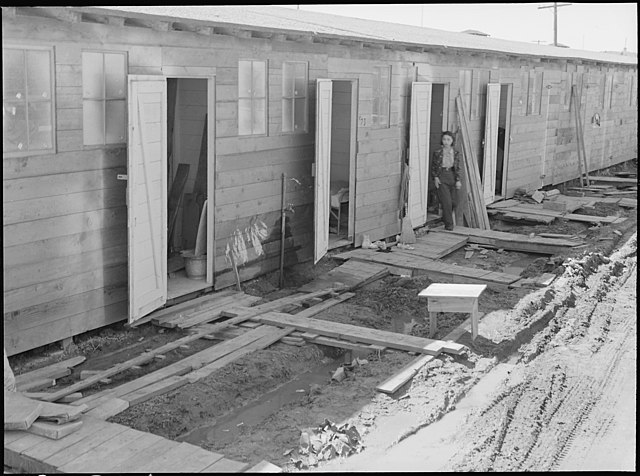Topaz War Relocation Center
The Topaz War Relocation Center, also known as the Central Utah Relocation Center (Topaz) and briefly as the Abraham Relocation Center, was an American concentration camp in which Americans of Japanese descent and immigrants who had come to the United States from Japan, called Nikkei were incarcerated. President Franklin Roosevelt signed Executive Order 9066 in February 1942, ordering people of Japanese ancestry to be incarcerated in what were euphemistically called "relocation centers" like Topaz during World War II. Most of the people incarcerated at Topaz came from the Tanforan Assembly Center and previously lived in the San Francisco Bay Area. The camp was opened in September 1942 and closed in October 1945.
Hog farm where internees raised pork for the camp's kitchen
Internees clear land for agricultural use.
James Hatsuaki Wakasa and his dog in an undated photograph. A 63-year-old chef from San Francisco, Wakasa was shot and killed by a military sentry while walking his dog inside the barbed-wire fence.
The remains of the camp as seen from 20,000 feet in 2009
The Tanforan Assembly Center was created to temporarily detain nearly 8,000 Japanese Americans, mostly from the San Francisco Bay Area, under the auspices of Executive Order 9066. After the order was signed in February 1942, the Wartime Civil Control Administration acquired Tanforan Racetrack on April 4 for use as a temporary assembly center; plans called for the site to be used to accommodate up to 10,000 "evacuees" while permanent relocation sites were being prepared further inland. The Tanforan Assembly Center began operation in late April 1942, the first stop for thousands who were forced to relocate and undergo internment during World War II. The majority were U.S. citizens of Japanese ancestry who were born in the United States. Tanforan Assembly Center was operated for slightly less than six months; most detainees at Tanforan were transferred to the Topaz War Relocation Center in Utah, starting in September. The transfer to Topaz was completed by mid-October, and the site was turned over to the Army a few weeks later.

A family arrives at the Tanforan grandstand. Dorothea Lange, 1942.
All maintenance work, repair and construction is done by volunteer workers of Japanese ancestry. This gang of boys and young men are digging a drainage tank along the front of one of the barracks. Lange, 1942.
Converted horse stalls
Barracks








